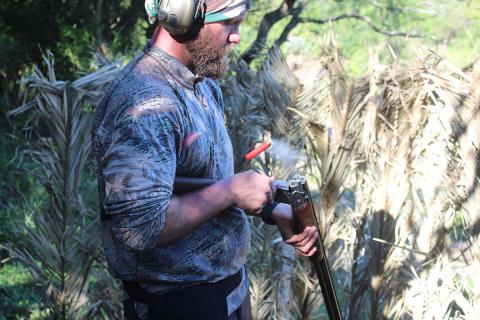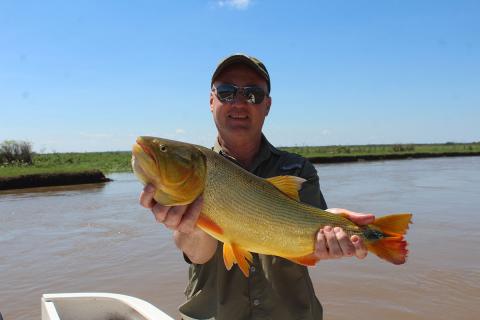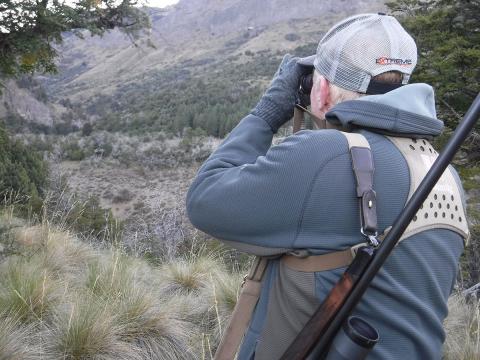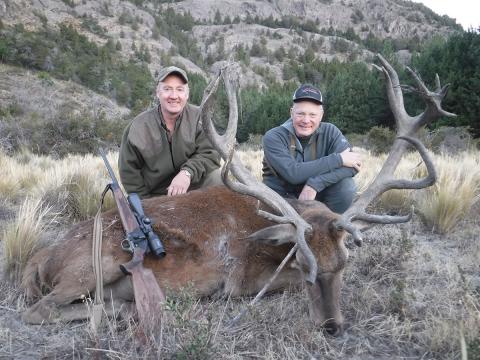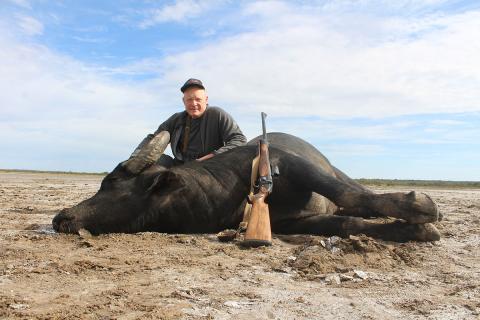Argentina Mixed Bag
If you’re a shotgunner South America’s high-volume wingshooting must be on your bucket list. If you’re a big-game hunter, you simply must hunt red stag in the roar. I’m not a serious angler but, among those who are, I’m told that the bright golden tail-walking dorado is considered among the world’s top freshwater game fish. Argentina offers all three…and a whole lot more!
North to south, Argentina is as long as the continental United States is wide from sea to shining sea. The far north is tropical jungle, the beginning of the Amazon Basin; the southernmost tip is the gateway to Antarctica. In between, and from the Atlantic to the spine of the Andes, lie hundreds and hundreds of miles of Argentina!
As a destination Argentina probably draws the largest number of foreign hunters of any country in the world, approaching 20,000! Wingshooting is by far the largest draw and most famous is her dove shooting. Up here the dove is an important gamebird. Down there, doves are considered an agrarian pest; guesstimates run into the hundreds of millions. Doves don’t fly any slower in Argentina, but the season is year ‘round with no bag limit. Shooting is considered necessary control. Some of the larger lodges go through a million shotshells annually! Though not as numerous as doves, wild pigeons are widespread and plentiful, and can also be hunted year-round. Pigeons fly as fast as doves and are equally aerobatic. A pigeon shoot over decoys is a fantastic experience.
Doves and pigeons are hardly the whole picture of Argentinean wingshooting! The well-watered north has fantastic waterfowl, and agricultural areas have three species of perdiz (partridge). Hunting of waterfowl and perdiz is controlled by seasons and bag limits. In season, interesting combinations can be put together.
For anglers in the north the dorado is the premier attraction along with the sharp-toothed piranha and other tropical species, but Patagonia has some of the world’s most famous trout streams. Anglers who don’t hunt have plenty of reasons to visit Argentina as do serious shotgunners with little interest in big game!
Big-game hunters also have plenty of reasons to visit Argentina. The best opportunities today are for introduced species. Several have been there long enough to be part of the landscape. Red deer were introduced more than a century ago and today is Argentina’s premier big-game animal. Obviously, Argentina doesn’t have a patent on red deer, but Argentina has some of the world’s best stag hunting. The red deer continues to expand. I’ve seen them as far north as Santa Fe and Santiago del Esteros, but the primarily population is from La Pampa southward through Patagonia, where the majority of red stag hunting is centered.
Much of the north is too tropical to be ideal red stag habitat, but axis deer and blackbuck offer excellent free-range hunting with very fine trophy quality. A surprise in Argentinean hunting is how widespread water buffaloes really are! Introduced as an alternate source for meat, milk, and ‘buffalo mozzarella,’ water buffaloes respect no fences. Over time they have spread out and occupied much of northern Argentina, blocked only in the south where winters are too harsh. Fallow deer and European mouflon are also widespread. Feral hogs are endemic.
An Ambitious Plan
Combinations beckon: Anglers need time in the north fishing for dorado, and then down south along pristine trout streams. An avid shotgunner can combine high-volume dove and pigeon shooting with waterfowl and perdiz over pointing dogs. A serious big-game hunter would be drawn to roaring red stags, but there’s so much more!
Argentina is nearly a third the size of the United States, but with only one-sixth the population. It is not a one-vacation destination. I’ve hunted there a half-dozen times and it’s all good. This year I had a mission to film several TV episodes so I offered Marcelo Sodiro and his South American Adventure Safaris a challenge. If we gave it a couple of weeks, how much could we see, while ensuring quality experience along the way?
Turns out we could do quite a lot! Argentina has excellent road networks and good internal flights. We couldn’t see it all, but with careful planning we saw a whole bunch. We started in the north at La Cortadera lodge in Entre Rios province and then on north into Corrientes, where we hunted from Malalcue lodge. Both of these areas were in the inland delta of the massive Parana` River, in what they call “wet pampas,” well-watered plains. From there we went south into La Pampa, hunting on estancia El Carrizal in “dry pampas,” brushy, arid plains not unlike the mesquite flats of the South Texas Brush Country. The final stop took us to San Martin de los Andes, in Patagonia. We hunted in the shadows of the Andes on pine-covered ridges at Parque Diana, established in the 1960s as Argentina’s first big-game destination. We started in early March, hoping that the red stags would be roaring in Patagonia!
What’s Not To Like?
Although connections were good, between each stop we flew back to the domestic terminal in Buenos Aires, then onward. This took time, although there’s nothing wrong with stopping over in Buenos Aires. Friends Heather Smith and Gary Wells joined us on this fast-paced tour, just a few days at each location. It’s a tribute to great planning and amazing hunting that, across the board, we hit all the marks!
I don’t suggest that such a hectic schedule is right for everybody. Although terrain, habitat and game varied widely, each of the four locations deserved more time and we were sorry to have to move on.
But that’s typical of Argentina, where the food is fantastic and the Malbec is wonderful. There’s just one thing, Argentina probably isn’t an ideal place for vegans. There are many more cattle than people in Argentina. They’re proud of their beef and know how to prepare it and do equally great work with game meat, fish, and fowl. We hunted hard every day, but Argentina is also perhaps not the best place to plan to lose weight! Every meal is an experience, and that’s part of the culture.
Speaking of culture, Argentina has strong European roots. Hospitality is second to none and although a Spanish-speaking country, English is a widely-spoken second language not only in the big cities, but in the countryside. Communication is rarely an issue. The exchange rate is extremely favorable, even in cosmopolitan Buenos Aires I’m always shocked at the reasonable prices. In the tourism industry it’s common to rate destinations where “the U.S. dollar goes the farthest.” Argentina is typically on the list.
I took my own firearms: A Blaser F16 12-gauge and a Blaser R8 with .270 barrel for deer and .375 barrel for water buffalo. Obtaining permits on arrival was not a problem. However, it took time and when you fly in or out of a local airport the police will check the guns. This also takes time and we were moving around a lot! Ultimately it depends on you and how important it is to hunt with your own firearms. Take your choice because perfectly good guns are readily available. Bird-shooting lodges will have a whole rack of good shotguns, often Benelli and Beretta. In rifles, well-scoped .270, 7mm magnum, .30-06, and .300s seem most common and water buffalo areas will have .375s. Gary and Heather borrowed firearms and had no problems. Bringing my own I had no problems, either, but at every transition they had to wait for me while I did the police clearance.
Catch A Fish, Shoot A Bird, Catch The Roar
As with most things, timing is everything. Some provinces have set seasons, even for non-native game. Timing doesn’t matter much for horned animals such as blackbuck, mouflon, and water buffalo and like everywhere else, at least some axis deer will be in hard antler at any time. Some situations however, require careful planning. Down south, trout season is early in the year and I’m told this is the best time for dorado.
Up in Entre Rios in early March we caught a good time for dorado, except rains had been heavy and the waters of the Parana` were very muddy. The riverine habitat was gorgeous, weather sunny and warm, but we tried spot after spot, both casting and trolling, without a hit. Outfitter Marcelo Sodiro was with us and guide Omar knew his stuff, but the silt-laden water was an obvious problem. We caught a couple of piranhas and I brought in a weird-looking and really tasty catfish. We kept trying and then we hit the jackpot. When a dorado hits you know you’ve got something different on the line. They hit hard and come up jumping! You won’t boat them all, but we brought in a couple of really good ones, what a gorgeous golden fish.
In both Entre Rios and Corrientes the doves were everywhere, jamming the telephone lines and passing overhead. This region is not Argentina’s most famous wingshooting area, but evidence suggests the doves in their millions are expanding and increasing. Scouting roosts and fields where birds are especially plentiful is important to good shooting. One afternoon Marcelo posted me on atop a steep bluff looking down into a brushy streambed. He has shot this roost for 20 years and dozens of birds were constantly in view. It would have made a great sporting clays station, with the doves coming low and fast, then swooping left, right and straight overhead.
One thing about Argentina’s awesome dove shooting, you have time and opportunity to recognize and correct bad habits. I started out missing badly and I couldn’t figure it out. I asked my bird guy to stand behind me, in seconds he told me I was shooting in front of the birds! Darn, I have no idea how you can consistently over-lead doves, but I certainly was. I corrected, and immediately started hitting.
Catching the red stag roar is probably the trickiest part, no different from anywhere else. Remember, seasons are opposite down there, so March is very early autumn. My experience is the roar hits earlier in Argentina than in New Zealand and, in Argentina, it comes earlier in southern Patagonia than in warmer La Pampa. In mid-March the stags were just starting to roar at El Carrizal. Just a few days later and a few hundred miles farther south, the stags were roaring nicely. The genuine peak was probably still a few days off, but in early morning and late afternoon the hills were echoing and we heard them roaring all night long. Perfect!
Spectacular Deer Hunting
Some places are better than others, and the roar varies a bit from year to year, but I’ve hunted red stags in in several places and common description really is Spectacular! La Pampa is rolling, brushy country, where it’s almost essential to hunt by sound. Farther south the country opens up. Following the roar is still the preferred method, but hunting by glassing and stalking is more practical. Quality is generally good, in my view some of the best free-range stag hunting there is, but on an increasing basis, some landowners are improving their genetics and Argentina’s stags are getting bigger. This was certainly true of Parque Diana! I saw a lot of stags that, well, were bigger than I’d agreed to.
That’s part of the deal, but also no problem. We were seeing multiple stags’ mornings and evening and hearing lots of roaring. So we passed on a whole bunch of young stags and turned down several that were just plain too big. It was just a matter of time before we saw a good stag that was exactly what I was looking for. On the evening of the third day we climbed a big ridge fruitlessly following the receding roars of a deep-voiced stag we never saw. With sunset approaching Marcelo thought we should look elsewhere, so we angled back down the ridge and were halfway down when we heard a new roar just ahead of us. The stag was standing in open ground at the base of the ridge, 150 yards below us. This time, with no hesitation, Marcelo set up the sticks and said, “Shoot that one!” So, I did, a gorgeous stag. On the same day both Gary Wells and Dennis Jordan shot the monsters they were looking for, a pretty happy camp that evening!
We had planned our hunt around red stag being a main event, so we had five days at Parque Diana our final stop so that hopefully, the red stags would be roaring well by the time we got there. Obviously, this worked, but that was not the only part of the plan that worked perfectly. A decade ago I did a long book project in Argentina, but one of the things I failed to do was take a free-range axis deer. So, up in Corrientes Province we were hunting both axis deer and blackbuck. Tall grass made hunting blackbuck very difficult, but Gary, Heather, and I all shot really fine axis deer, amazing.
Hunting with Sergio Wizensky, we saw two big bucks slip into a pine plantation. The wind was perfect—but the grass was waist-high between the rows of trees. We played cat-and-mouse with those deer for a half-hour, staying with them but never able to see more than just the polished white tips of their antlers above the grass. Both were good bucks, but after a bit we figured out that one, probably taller, was missing its third points, while the second was perfect. It was frustrating, just those white tips never a glimpse of spotted hide as we followed them from row to row. Then, finally one made a mistake. I could see the antlers, knew it was the correct one and when he stepped into a tiny opening, I could finally see spots. He was a beautiful representative of the most beautiful deer in the world.
Although the red stags were just kicking off in La Pampa the quality is good. I saw a giant on El Carrizal but we drove away from him because we weren’t looking for stags. We had just two days there on this whirlwind adventure, risky. The first day Heather shot a gorgeous blackbuck and Gary took a fine old water buffalo, while a big herd of buffaloes stymied my team on a half-dozen approaches. The next day, hunting with Paco Rodriguez, I took a monstrous buffalo. In the evening Gary surprised me completely, coming back to camp with an incredible fallow deer, old with big paddles and lots of points. All of these animals were free range, two productive days in La Pampa!
A Note On Native Game
Argentina has a wide selection of native big game. The southern huemul, marsh deer, pampas deer and southern pudu are completely protected, likewise the maned wolf and the few jaguars that tip into northernmost Argentina. Native species that are hunted include capybara, brocket deer, puma and both white-lipped and collared peccary. There is an unfortunate catch, native game species can no longer be exported. The exception is there are a now a few permits for exporting pumas under certain conditions. The ranches we hunted in Corrientes, also good for brocket deer, were overrun with capybaras. Just seeing them in big groups was a highlight of the trip. The meat is highly prized, as is the waterproof leather. We took our time and shot a big male but, regrettably, this is no longer an animal that can be taken home. –Craig Boddington


